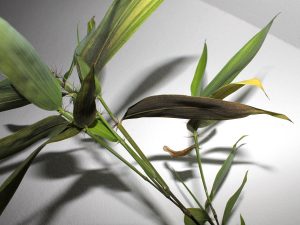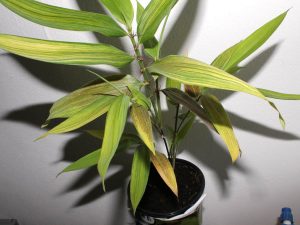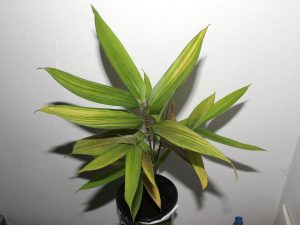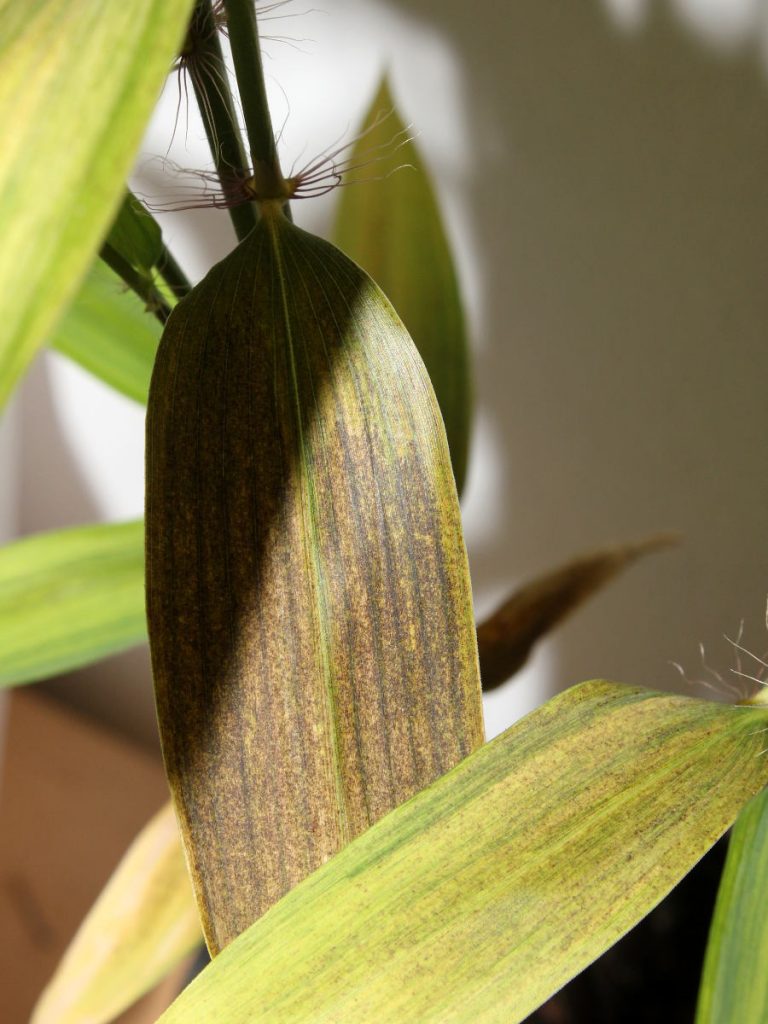Bamboo fungal infection?

Temperature outside dropped considerably, and I’m afraid that some of my less hardy bamboos will get completely toasted this year. In late fall, I have taken my variegated Phyllostachys arcana ‘Luteosulcata’ seedlings inside for overwintering. In just a week or so, I have noticed dark spots on some of their leaves. All the plants seemed to have been affected, but the issue seemes to be a bit different on the greener seedling. The darker, less variegated seedling started getting larger spots on it’s leaves. These spots appeared on old and on new leaves, young leaves seemed to be much more affected than the hardened ones. This seedling is overall happy and started shooting vigorously. New shoots are affected, but at this time, it seems like the infection is slowly fading out as new leaves take longer to develop the spots.

Other two, more variegated seedlings, took the same time to develop tiny black spots all over the leaf. These are much less visible from upper side of the leaf and hit the bottom side first. New leaves appear healthy at first, but when they age to a month or two, they start getting dark brown. Bottom side of the leaf gets hit first with just a couple of brown spots, eventually, it spreads all the way to the leaf tip and through the leaf to the upper side of leaf. I have cut off all the leaves from the largest seedling at the very beginning, when I first saw the issue. It doesn’t show any issues for now, but it grows really slow. It shows signs of recovery. I thoroughly sprayed all the seedlings with insecticide and it didn’t do much good.

When I took the seedlings inside, they all started growing rapidly. All of them started shooting and don’t really seem to be bothered by their infection. Especially the greener form started acting like the super-aggressive seedling from last winter. I keep temperature around 21°C – 25°C, relative humidity around 45% and around 16 hour light cycle. They have a fan nearby, which makes sure there is always some airflow. I will leave the seedlings inside for the winter and keep an eye on them. If they start to decline, I’ll bath them in fungicide, if not, I’ll wait for the spring to come and thoroughly spray them before planting them outside the next season.
Did any of you ever noticed anything similar on any of your bamboos? Hopefully I can identify the bamboo fungal infection, so I can get rid of it before the spring.

5 thoughts on “Bamboo fungal infection?”
This is interesting. I had around 7 or 8 moso bamboos, and half of them perished after exhibiting similar damages. Seeing as this is my first winter living in a house since high school (been living in a one-room apartment for college), this is also my first go at overwintering. It seems I had forgotten about airflow… My more rough-textured colocasia varieties and my one xanthosoma are all showing signs of fungus, and lack of air movement may just be part of the cause … Thank you as always! Very interesting posts as usual 🙂
My Moso seedlings didn’t show this kind of damage. Main issue with Moso seedlings was yellowing caused by overwatering. I have lost many because my black nursery pots started to overheat in late spring which fried their roots. Watering the wilted and thirsty looking plants did the rest. Affected Moso seedlings ceased to grow, my seedlings are growing just as fast as if they were healthy.
I have two fans positioned above the plants and there is always some airflow. Air humidity was also quite low and temperature high. I’m now trying with higher humidity and lower night temperatures. I also applied some aspirin, hopefully it does the trick.
Thank you!
Hi,
I bumped into your post on lesions on bamboo leaves. I was wondering whether you could confirm that the damage was caused by a fungus. I have identical symptoms on my bamboo but it seems to me that the cause is rather abiotic (problem with temperature, watering, pH, fertilizer, …?). What is your idea?
Regards,
Kris
Hello,
I was guessing about possible causes and fungal cause was just one of them. It was strange because not all seedlings exhibited the same issue, it even seemed some culms are more affected than others.
Until now, I’m not really certain what the cause was, but the same thing is happening on at least one of the variegated seedlings and again, one culm can be heavily damaged while all the other culms remain intact.
The fact that the seedlings are variegated (heavily), they are prone to all kinds of damage, strong light exposure is number one cause of damage it shows today. Necrotic spots like those in the post you’ve commented are still present, but not in the insane amount like it did back then. I’ve been growing them inside under artificial light which could also be a factor.
I agree with you, it’s almost certain now that there was no fungal infestation and the cause is abiotic. The cause though is still a mystery.
If you check my newer posts about Phyllostachys arcana seedlings (especially variegated), you can see how they look now that they are outside.
Regards!
You’ve posted the question under the wrong post. This one is about propagating blueberries. 🙂
Anyway, you can use any other inert material that will offer some hydration to the scion while it forms the callus. You can use moistened sterilized peat, it should be at lest as effective.
hickory has much harder nut shell, so the same technique I used would not be possible. You can try grafting on an exiting sprout as the nut opens, without cutting off the part of the shell, which I did. I think it should work, but it might be a bit less successful, because of issues most if not all Juglans trees have. You can try it and report back. Sadly I don’t have pecans to try it myself. I always wanted to grow them though.